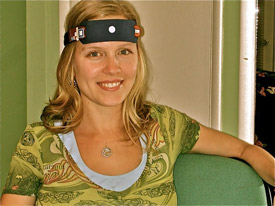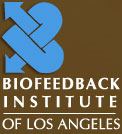What is Biofeedback?
Biofeedback is a training technique in which people are taught to improve their health and performance by using signals from their own bodies. It is scientifically based and validated by studies and clinical practice. The word "biofeedback" was coined in 1969 to describe laboratory procedures (developed in the 1940's) that trained research subjects to alter brain activity, blood pressure, muscle tension, heart rate and other bodily functions that are not normally controlled voluntarily. Biofeedback is a training technique in which people are taught to improve their health and performance by using signals from their own bodies.
One commonly used device, for example, picks up electrical signals from the muscles and translates the signals into a form that people can detect. This device triggers a flashing light or activates a beeper every time muscles become more tense. If one wants to relax tense muscles, one must try to slow down the flashing or beeping. People learn to associate sensations from the muscle with actual levels of tension and develop a new, healthy habit of keeping muscles only as tense as is necessary for as long as necessary. After treatment, individuals are then able to repeat this response at will without being attached to the sensors.
Other biological functions which are commonly measured and used in similar ways to help people learn to control their physical functioning are skin temperature, heart rate, sweat gland activity, and brainwave activity.
Clinicians rely on complicated biofeedback machines in somewhat the same way that you rely on your scale or thermometer. Their machines can detect a person's internal bodily functions with far greater sensitivity and precision than a person can alone. This information may be valuable. Both clients and therapists use it to gauge and direct the progress of training.
Although most people initially viewed these practices with skepticism, researchers proved that many individuals could alter their involuntary responses by being "fed back" information either visually or audibly about what was occurring in their bodies.
In addition, studies have shown that we have more control over so-called involuntary bodily functions than we once thought possible. As a a result, biofeedback can train individuals with techniques for living a healthier life overall - whether one is afflicted with a medical condition or not.
What is HemoEncephaloGraphy?
HEG Instructions
Appendix I: Toomim's Cognitive Behavior Questionnaire
Appendix II: TOVA
Appendix III: MicroCog
PDF (Adobe Acrobat©) format
HEG (hemoencephalography) is the study of blood flow in the brain. More specifically, it is the study of voluntarily controlled blood flow or oxygenation in specifically chosen brain areas. Certain areas of the brain do certain things. The prefrontal cortex is involved with executive functions such as short-term attention and organizing; the temporal lobes are involved with memory functions, auditory processing, word finding and emotional responses and the parietal lobes are involved with direction. Brain anatomy and biology are important elements to the understanding of brain function.
Certain brain areas are associated with specific learning, behavioral or emotional challenges. For example, executive/organizational failures and impulse control issues are generally marked by prefrontal cortex trouble. Memory challenges, mood swings including temper (anger) issues and word finding trouble, usually indicate problems in temporal lobes. People who get lost easily may have issues in the parietal region of the brain. Once we know your challenge we can target your brain exercise training.
Blood brings oxygen and the basic nutrient glucose at life sustaining levels to all parts of the brain. Our brains have an amazing ability to supply extra blood preferentially to areas in current use. Even in repose the brain uses 1/5 of all the energy used in the body. Brain temperature rises in the used (venous) blood. If we used the entire brain at one time it would overheat and be severely damaged. The flow of blood cools the brain and prevents overheating.
Active brain areas are marked by high oxygen density and higher than normal temperature. Simple measurements can locate active areas. Note here that we have no sense that tells us where an active area is located. For example when we stand, activity occurs in the motor strip across the top of the head. We have no sensation with information about the exact location of that active bit of tissue.
From infancy on, we have learned to use specific bits of brain tissue for accomplishing familiar tasks. We carry out the same learning process for anything new. We may want to do something we see others do or we try to do something that seems possible. Initially we accomplished it by trial and error. In trying, we find some modicum of success. We are encouraged so we try again and again. We improve as we go.
 Fortunately, we can use a sophisticated infrared thermometer, passive infrared HEG (pirHEG), developed by my esteemed colleague, Jeffrey A. Carmen, or an optical probe, near infrared HEG (nirHEG) developed by the originator of HEG Hershel Toomim, that shines light through the skin and skull to assess the color of brain tissue. Oxygenated arterial blood is red, deoxygenated venous blood is blue. Increased demand for nutrition results in faster blood flow and redder blood in the tissues.
Fortunately, we can use a sophisticated infrared thermometer, passive infrared HEG (pirHEG), developed by my esteemed colleague, Jeffrey A. Carmen, or an optical probe, near infrared HEG (nirHEG) developed by the originator of HEG Hershel Toomim, that shines light through the skin and skull to assess the color of brain tissue. Oxygenated arterial blood is red, deoxygenated venous blood is blue. Increased demand for nutrition results in faster blood flow and redder blood in the tissues.
With these facts in mind we have HEG - an outstanding method of providing neurofeedback.
back to top
Neurofeedback
Neurofeedback is a form of biofeedback in which you are given information about the activity of your brain, and thus you can control it. EEG informs you about the activity of neuronal firing in your brain. HEG (hemoencephalography) gives you information about blood flow in your brain. You require blood to supply the oxygen and other nutrients that make the neurons fire.
SPECT and PET scans are measures of blood flow. Research has shown that HEG is twice as effective as EEG in handling ADD, ADHD, Autism, Asperger's, and Toxic Encephalopathy. It is also proving useful in depression, schizophrenia, and bipolar disorders.
back to top
Psychophysiology
Psychophysiology is the field which studies the relationship between mental activity and physical functions - in other words, investigates the mind-body connection in a scientific way. Psychophysiologists are interested in how mental characteristics affect the body, how we experience information from our body and what changes happen when people experience particular emotions.
Applied psychophysiology is the discipline which uses this information for practical purposes. For example, psychophysiologists do research to find new ways to teach people better ways to learn to control body functions which may be causing health problems. Psychophysiology is one way to predict and prevent one's stress-related health problems.
back to top


